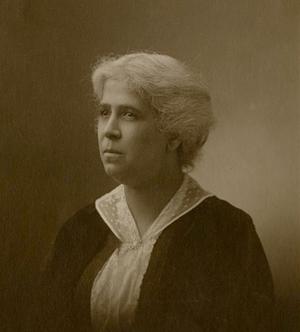Mary Evans Wilson facts for kids
Quick facts for kids
Mary Evans Wilson
|
|
|---|---|

Mary Evans Wilson ca. 1897
|
|
| Born |
Mary P. Evans
1866 Oberlin, Ohio, U.S.
|
| Died | March 28, 1928 South End, Boston, U.S.
|
| Resting place | Forest Hills Cemetery |
| Alma mater | Oberlin College |
| Known for | |
| Spouse(s) | Butler R. Wilson |
| Children | 6 |
| Relatives | Anna Evans Murray, (sister)
Daniel Alexander Payne Murray, (brother-in-law) Lillian Evanti, (niece) |
Mary Evans Wilson (1866-1928) was a very important person in the fight for civil rights in Boston. She helped start the Boston branch of the National Association for the Advancement of Colored People (NAACP). She also created the Women's Service Club, which still helps people today.
Contents
Early Life and Family
Mary P. Evans was born in Oberlin, Ohio, in 1866. She was one of nine children. Her parents were Henry Evans and Henrietta Leary Evans. Mary went to Oberlin College.
Mary's family was very active in fighting for fairness. In 1858, her father was arrested for trying to help a runaway slave. This event is known as the Oberlin–Wellington Rescue. Her uncle, Lewis Sheridan Leary, died during John Brown's raid at Harpers Ferry, West Virginia. Her cousin, John Anthony Copeland Jr., was also executed with Brown. Years later, Mary's mother gave a speech at Harpers Ferry. This was for the Niagara Movement, a civil rights group.
Mary's sister, Anna Evans Murray, was a teacher and community leader. She worked to create free kindergarten classes for Black children. Anna's husband, Daniel Murray, worked at the Library of Congress. He helped collect books by African American authors for a special exhibit in Paris.
Working for Change
Mary Evans moved to Washington, D.C., and taught in public schools for ten years. She also wrote a health and beauty column. This was for The Woman's Era, a newspaper for African-American women.
In 1894, Mary married Butler R. Wilson. He was a well-known civil rights lawyer in Boston. They moved to Boston and had six children.
In 1899, Mary Wilson gave a powerful speech. It was at an anti-lynching event in Boston. She spoke out against President William McKinley. She said he was not doing enough to stop lynching. She asked the government to step in and help. Other important women also spoke at this event.
Leading the NAACP
Mary and Butler Wilson helped start the Boston branch of the National Association for the Advancement of Colored People (NAACP). They were the most important Black leaders in the group. At that time, many leaders were white. Butler Wilson was the first secretary of the Boston branch. He later became its president.
Mary Wilson volunteered to travel and find new members. She helped thousands of people join the NAACP in New York, Ohio, and Pennsylvania. In 1916, she looked into unfair treatment at the New England Sanitarium. She also worked to get Boston department stores to hire Black saleswomen. She fought against unfair rules in Boston schools, too. Many people call her a "hero" of the Boston NAACP.
Women's Service Club
During World War I, Mary Wilson started a knitting group. About 350 women and girls made gloves and scarves. These were for Black soldiers from Boston. This knitting group later became the Women's Service Club in 1919. It is a charity that still helps people today. Its main office is in the South End of Boston. It is one of the oldest groups for women of color in Boston.
Mary Wilson also served on the board of the Boston Trade School.
Death and Legacy
Mary Evans Wilson passed away at her home in Boston on March 28, 1928. She is buried next to her husband in the Forest Hills Cemetery.
Mary Wilson is remembered for her work with the Women's Service Club. Her story is part of the Boston Women's Heritage Trail.

